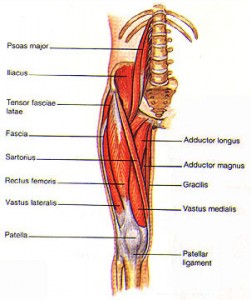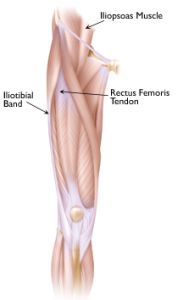Having written recently about the erector spinae and the rectus abdominis, I’m working through the muscles of the lower cross syndrome that I mentioned when writing about Vladimir Janda.
Today we’ll look at the psoas major and rectus femoris, two muscles that have made frequent appearances on the blog.
The psoas major and rectus femoris both flex the hip. Additionally, the psoas externally rotates the leg and rectus femoris extends the leg at the knee.
As with so many of the surrounding muscles it is hard to have problems with the psoas major that don’t also involve the rectus femoris and vice versa.
These two muscles might suffer more from poor posture than any other in the body due to their proximity to the temple of postural confusion that is the pelvis.
Good posture means that our bones are aligned in a way that allows them to stack one upon the other in a fashion that allows weight to transfer through the bones.
When the bones are aligned in this way the muscles have an opportunity to live in balanced harmony.
When the bones are misaligned the muscles will suffer because they will have to pick up the supportive slack created by the messed up bones.
The pelvis is like the hub of a wheel. If it is off center the whole wheel will suffer and it won’t be able to turn efficiently.
The same goes for the pelvis and the body’s posture. The alignment of the pelvis determines everything that happens above and below it. The slightest deviation from neutral will mess with everything that emanates from the pelvis.
The psoas major is one of only three muscles that connect the legs to the spine and the only one that does so from the front of the body.
The rectus femoris is the only one of the four quadriceps muscles that connects to the pelvis.
These two muscles are the main flexors of the hip and have a hard time functioning successfully when the pelvis is improperly aligned.
There are two main postural problems with the pelvis.
- Most people are living with pelvis tucked under, or tilted posteriorly.
- The legs usually fail to line up underneath the pelvis. They usually lean slightly forward which pulls on the pelvis, often towards a posterior tilt.
When these two issues occur, both the psoas major and rectus femoris are pushed out of their comfort zone and natural resting place.
The forward thrust of the legs and the pelvis put undue strain on the rectus femoris actually asking it bear quite a bit of weight from the upper body which is not at all its job.
In the case of the psoas, the forward leaning legs, which take the pubic bone along for the ride, push or pull the psoas major forward affecting the lumbar spine negatively increasing its curve in the process.
What a mess! But the fix is simple, align the bones and free the muscles. That is the lesson of today’s post.



